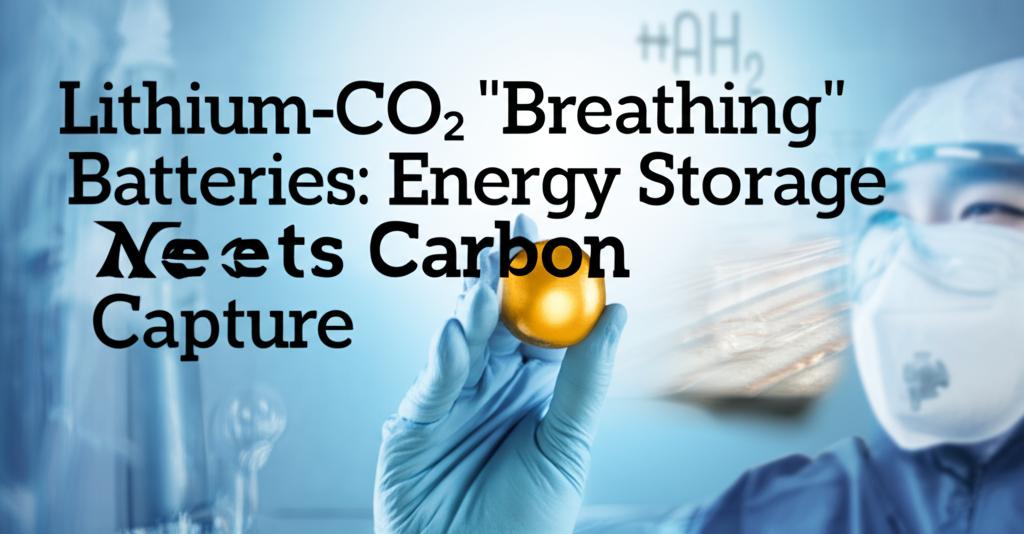A significant advancement in energy storage technology is poised to address two of the world's most pressing challenges: the need for efficient energy storage and the urgency of reducing greenhouse gas emissions. Lithium-carbon dioxide (Li-CO2) "breathing" batteries are emerging as a promising solution, capable of not only storing substantial amounts of energy but also capturing CO2 directly from the atmosphere. This dual functionality marks a potentially transformative step towards a cleaner energy future.
Overcoming Previous Hurdles with Innovative CatalystsHistorically, the development of Li-CO2 batteries has been hampered by several obstacles. These included low efficiency, rapid degradation, difficulties in recharging, and a reliance on expensive, rare materials like platinum for catalysts. However, recent breakthroughs, particularly from researchers at the University of Surrey, have demonstrated effective ways to overcome these limitations.
A key innovation lies in the use of a low-cost and scalable catalyst, caesium phosphomolybdate (CPM). Scientists discovered that incorporating CPM significantly improves battery performance. Through computer modeling and laboratory experiments, batteries utilizing the CPM catalyst have shown the ability to store considerably more energy, recharge with far less power, and endure over 100 cycles. This breakthrough is crucial because it moves away from the need for precious metals, making the technology more economically viable and scalable.
How "Breathing" Batteries WorkUnlike conventional batteries that solely store and release electrical energy, Li-CO2 batteries operate through a fascinating "breathing" mechanism. During the discharge phase, the battery effectively absorbs carbon dioxide from the surrounding environment and, through an electrochemical reaction with lithium, converts it into energy and lithium carbonate (Li2CO3). This process not only generates power but also sequesters CO2. The reversibility of this reaction is key, allowing the battery to be recharged, releasing the CO2 in a controlled manner or potentially storing it permanently.
Researchers have focused on understanding and optimizing the chemical reactions within the battery. Post-mortem analysis of battery components after charge and discharge cycles has confirmed the reliable formation and removal of lithium carbonate, a crucial factor for long-term stability and use. Computer modeling using density functional theory (DFT) has further elucidated how catalysts like CPM, with their stable and porous structures, provide an ideal environment for the necessary chemical reactions to occur efficiently.
The Significance of Reduced OverpotentialOne of the major challenges in Li-CO2 battery development has been "overpotential"—the extra energy required to initiate the chemical reactions during charge and discharge cycles. This is akin to needing an extra push to get a bicycle over a hill before it can coast. High overpotential leads to energy loss and reduced efficiency. The new CPM catalyst has been shown to significantly "flatten that hill," meaning the battery loses far less energy during each cycle, leading to greater overall efficiency.
Accelerating Catalyst DevelopmentBeyond specific catalyst discoveries, new methodologies are also accelerating progress in the field. Researchers have developed a lab-on-a-chip electrochemical testing platform. This innovative tool allows for the simultaneous evaluation of various electrocatalysts, optimization of operating conditions, and the study of CO2 conversion in high-performance Li-CO2 batteries. This approach is more cost-effective, efficient, and controllable than traditional methods for developing and testing catalyst materials.
Broader Implications and Future PotentialThe advancements in Li-CO2 battery technology hold significant promise. With their high theoretical specific energy density (around 1876 Wh/kg), these batteries have the potential to outperform current lithium-ion technologies.
The implications extend beyond terrestrial applications. Given that the atmosphere of Mars is predominantly CO2 (around 95%), Li-CO2 batteries could one day be a viable power source for missions to the Red Planet. Closer to home, if successfully commercialized, these batteries could play a crucial role in reducing emissions from the transportation sector and various industrial sources.
While the technology is still in relatively early stages of development, the recent breakthroughs in catalyst design and understanding of the underlying electrochemical mechanisms are paving the way for practical, scalable, and economically viable Li-CO2 batteries. Continued research will focus on further optimizing catalyst interactions with electrodes and electrolytes, enhancing cycle life, and scaling up manufacturing processes. The prospect of an energy storage solution that actively contributes to carbon capture offers a compelling pathway towards a more sustainable energy landscape.

